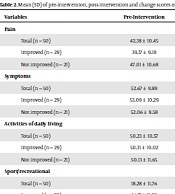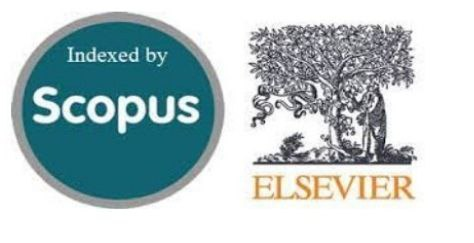Responsiveness and the Minimal Important Change of Knee Injury and Osteoarthritis Outcome Score Following Physiotherapy Intervention in Iraqi People with Knee Osteoarthritis
Keywords:
KOOS, Psychometric Properties, Minimal Important Changes, Knee Osteoarthritis, PhysiotherapyAbstract
Background: The Knee Injury Osteoarthritis Outcome Score (KOOS) is a widely used patient-reported questionnaire to evaluate individuals with knee osteoarthritis or a history of knee injuries. Objectives: The aim of this study was to evaluate the responsiveness and establish the minimal important change (MIC) for the Arabic version of KOOS in Iraqi individuals with knee osteoarthritis following physiotherapy intervention. Methods: Fifty volunteers (13 male and 37 female, mean age: 59.3 ± 9.6 years old) with an orthopedic diagnosis of knee osteoarthritis participated in this study. The Arabic KOOS was completed by the participants once before the intervention and once after completing a 4-week physiotherapy treatment program. A seven-item global rating of change scale was used as an external anchor to assess the participants' opinion about the treatment and its possible changes. Responsiveness was evaluated by calculating the receiver operating characteristic (ROC) curve, and the MIC was established by identifying an optimal cut-off on the ROC curve. Results: All subscales of the Arabic KOOS showed an area under the curve > 0.70. The MICs reflecting the values required by the participants to feel the improvement were 15.5, 14.5, 11, 11.5, and 12.5 for the pain, symptoms, activities of daily living, sports and recreation, and quality of life subscales, respectively. Conclusions: All subscales of the Arabic KOOS are responsive to physiotherapy treatment. Therapists and researchers can use the MIC values to evaluate whether their prescribed treatment was satisfactory and effective from their patients' point of view.
Downloads
References
1. Vaughan MW, LaValley MP, Felson DT, Orsmond GI, Niu J, Lewis CE,
et al. Affect and Incident Participation Restriction in Adults With
Knee Osteoarthritis. Arthritis Care Res (Hoboken). 2018;70(4):542–9.
[PubMed ID: 28686817]. [PubMed Central ID: PMC6492559].
https://doi.org/10.1002/acr.23308.
2. Bernad-Pineda M, de Las Heras-Sotos J, Garces-Puentes MV. [Quality
of life in patients with knee and hip osteoarthritis]. Rev Esp
Cir Ortop Traumatol. 2014;58(5):283–9. [PubMed ID: 25022212].
https://doi.org/10.1016/j.recot.2014.04.005.
3. van Dijk GM, Veenhof C, Lankhorst GJ, Dekker J. Limitations in
activities in patients with osteoarthritis of the hip or knee: the
relationship with body functions, comorbidity and cognitive
functioning. Disabil Rehabil. 2009;31(20):1685–91. [PubMed ID:
19479564]. https://doi.org/10.1080/09638280902736809.
4. Wallace IJ, Worthington S, Felson DT, Jurmain RD, Wren KT, Maijanen
H, et al. Knee osteoarthritis has doubled in prevalence since the
mid-20th century. Proc Natl Acad Sci U S A. 2017;114(35):9332–6.
[PubMed ID: 28808025]. [PubMed Central ID: PMC5584421].
https://doi.org/10.1073/pnas.1703856114.
5. Cui A, Li H, Wang D, Zhong J, Chen Y, Lu H. Global, regional
prevalence, incidence and risk factors of knee osteoarthritis in
population-based studies. EClinicalMedicine. 2020;29-30:100587.
[PubMed ID: 34505846]. [PubMed Central ID: PMC7704420].
https://doi.org/10.1016/j.eclinm.2020.100587.
6. Pollard B, Dixon D, Johnston M. Does the impact of osteoarthritis
vary by age, gender and social deprivation? A community
study using the International Classification of Functioning,
Disability and Health. Disabil Rehabil. 2014;36(17):1445–51.
[PubMed ID: 24164585]. [PubMed Central ID: PMC4196505].
https://doi.org/10.3109/09638288.2013.847123.
7. Ogunbode AM, Adebusoye LA, Olowookere OO, Alonge TO. Physical
functionality and self-rated health status of adult patients with knee
osteoarthritis presenting in a primary care clinic. Ethiop J Health
Sci. 2014;24(4):319–28. [PubMed ID: 25489196]. [PubMed Central ID:
PMC4248031]. https://doi.org/10.4314/ejhs.v24i4.7.
8. Mostafaee N, Negahban H, Shaterzadeh Yazdi MJ, Goharpey S,
Mehravar M, Pirayeh N. Responsiveness of a Persian version
of Knee Injury and Osteoarthritis Outcome Score and Tegner
activity scale in athletes with anterior cruciate ligament
reconstruction following physiotherapy treatment. Physiother
Theory Pract. 2020;36(9):1019–26. [PubMed ID: 30468412].
https://doi.org/10.1080/09593985.2018.1548672.
9. Collins NJ, Misra D, Felson DT, Crossley KM, Roos EM. Measures of knee
function: International Knee Documentation Committee (IKDC)
Subjective Knee Evaluation Form, Knee Injury and Osteoarthritis
Outcome Score (KOOS), Knee Injury and Osteoarthritis Outcome
Score Physical Function Short Form (KOOS-PS), Knee Outcome Survey
Activities of Daily Living Scale (KOS-ADL), Lysholm Knee Scoring
Scale, Oxford Knee Score (OKS), Western Ontario and McMaster
Universities Osteoarthritis Index (WOMAC), Activity Rating Scale
(ARS), and Tegner Activity Score (TAS). Arthritis Care Res (Hoboken).
2011;63 Suppl 11(0 11):S208–28. [PubMed ID: 22588746]. [PubMed
Central ID: PMC4336550]. https://doi.org/10.1002/acr.20632.
10. Husted JA, Cook RJ, Farewell VT, Gladman DD. Methods for
assessing responsiveness: a critical review and recommendations.
J Clin Epidemiol. 2000;53(5):459–68. [PubMed ID: 10812317].
https://doi.org/10.1016/s0895-4356(99)00206-1.
11. Ebrahimi N, Jalaie S, Salsabili N, Ansari NN, Naghdi S. Knee Injury
and Osteoarthritis Outcome Score in patients with isolated
meniscus injury; Validity and reliability. J Res Med Sci. 2017;22:55.
[PubMed ID: 28567074]. [PubMed Central ID: PMC5426089].
https://doi.org/10.4103/jrms.JRMS_941_16.
12. Roos EM, Lohmander LS. The Knee injury and Osteoarthritis Outcome
Score (KOOS): from joint injury to osteoarthritis. Health Qual Life
Outcomes. 2003;1:64. [PubMed ID: 14613558]. [PubMed Central ID:
PMC280702]. https://doi.org/10.1186/1477-7525-1-64.
13. Roos EM, Roos HP, Lohmander LS, Ekdahl C, Beynnon
BD. Knee Injury and Osteoarthritis Outcome Score
(KOOS)–development of a self-administered outcome measure. J
Orthop Sports Phys Ther. 1998;28(2):88–96. [PubMed ID: 9699158].
https://doi.org/10.2519/jospt.1998.28.2.88.
14. Collins NJ, Prinsen CA, Christensen R, Bartels EM, Terwee CB,
Roos EM. Knee Injury and Osteoarthritis Outcome Score (KOOS):
systematic review and meta-analysis of measurement properties.
Osteoarthritis Cartilage. 2016;24(8):1317–29. [PubMed ID: 27012756].
https://doi.org/10.1016/j.joca.2016.03.010.
15. Zhang QH, Du SX, Zheng GZ, Chang B, Xie D, Lin FX, et al. Reliability,
Validity, and Responsiveness of the Chinese Version of the Knee
Injury and Osteoarthritis Outcome Score (KOOS) in Patients
with Anterior Cruciate Ligament Reconstruction in Mainland
China. Z Orthop Unfall. 2019;157(1):42–7. [PubMed ID: 29969810].
https://doi.org/10.1055/a-0621-9504.
16. Salavati M, Mazaheri M, Negahban H, Sohani SM, Ebrahimian MR,
Ebrahimi I, et al. Validation of a Persian-version of Knee injury and
Osteoarthritis Outcome Score (KOOS) in Iranians with knee injuries.
Osteoarthritis Cartilage. 2008;16(10):1178–82. [PubMed ID: 18411065].
https://doi.org/10.1016/j.joca.2008.03.004.
17. Vaquero J, Longo UG, Forriol F, Martinelli N, Vethencourt R,
Denaro V. Reliability, validity and responsiveness of the Spanish
version of the Knee Injury and Osteoarthritis Outcome Score
(KOOS) in patients with chondral lesion of the knee. Knee Surg
Sports Traumatol Arthrosc. 2014;22(1):104–8. [PubMed ID: 23143387].
https://doi.org/10.1007/s00167-012-2290-1.
18. Moutzouri M, Tsoumpos P, Billis E, Papoutsidakis A, Gliatis J.
Cross-cultural translation and validation of the Greek version of
the Knee Injury and Osteoarthritis Outcome Score (KOOS) in patients
with total knee replacement. Disabil Rehabil. 2015;37(16):1477–83.
[PubMed ID: 25335550].https://doi.org/10.3109/09638288.2014.972583.
19. Jha RK, Sen RK, Tripathy SK, Gopinathan NR, Goyal T, Sharma
SK. Cross-cultural validation of Hindi version Knee Injury and
OsteoarthritisOutcome Score (KOOS) in osteoarthritis knee. Knee Surg
Sports Traumatol Arthrosc. 2021;29(6):1742–9. [PubMed ID: 32776241].
https://doi.org/10.1007/s00167-020-06211-1.
20. Nicolau C, Mendes L, Ciriaco M, Ferreira B, Baixinho CL, Fonseca C, et
al. Educational Intervention in Rehabilitation to Improve Functional
Capacity after Hip Arthroplasty: A Scoping Review. J Pers Med.
2022;12(5). [PubMed ID: 35629079]. [PubMed Central ID: PMC9147380].
https://doi.org/10.3390/jpm12050656.
21. Ornetti P, Parratte S, Gossec L, Tavernier C, Argenson JN, Roos EM, et
al. Cross-cultural adaptation and validation of the French version of
the Knee injury and Osteoarthritis Outcome Score (KOOS) in knee
osteoarthritis patients. Osteoarthr Cartil. 2008;16(4):423–8. [PubMed
ID: 17905602]. https://doi.org/10.1016/j.joca.2007.08.007.
22. Goncalves RS, Cabri J, Pinheiro JP, Ferreira PL, Gil J. Reliability, validity
and responsiveness of the Portuguese version of the Knee injury
and Osteoarthritis Outcome Score–Physical Function Short-form
(KOOS-PS). Osteoarthr Cartil. 2010;18(3):372–6. [PubMed ID: 19912982].
https://doi.org/10.1016/j.joca.2009.10.012.
23. Alfadhel SA, Vennu V, Alnahdi AH, Omar MT, Alasmari SH, AlJafri
Z, et al. Cross-cultural adaptation and validation of the Saudi
Arabic version of the Knee Injury and Osteoarthritis Outcome Score
(KOOS). Rheumatol Int. 2018;38(8):1547–55. [PubMed ID: 29882042].
https://doi.org/10.1007/s00296-018-4072-7.
24. Mokkink LB, Terwee CB, Knol DL, Stratford PW, Alonso J, Patrick DL, et
al. The COSMIN checklist for evaluating the methodological quality
of studies on measurement properties: a clarification of its content.
BMC Med Res Methodol. 2010;10:22. [PubMed ID: 20298572]. [PubMed
Central ID: PMC2848183]. https://doi.org/10.1186/1471-2288-10-22.
25. Terwee CB, Bot SD, de Boer MR, van der Windt DA, Knol DL, Dekker
J, et al. Quality criteria were proposed for measurement properties
of health status questionnaires. J Clin Epidemiol. 2007;60(1):34–42.
[PubMed ID: 17161752]. https://doi.org/10.1016/j.jclinepi.2006.03.012.
26. Sajadi S, Karimi M, Forogh B, Raissi GR, Zarnegar F, Ahadi T.
Randomized clinical trial comparing of transcranial direct current
stimulation (tDCS) and transcutaneous electrical nerve stimulation
(TENS) in knee osteoarthritis. Neurophysiol Clin. 2020;50(5):367–74.
[PubMed ID: 32912627]. https://doi.org/10.1016/j.neucli.2020.08.005.
27. French HP, Abbott JH, Galvin R. Adjunctive therapies in addition
to land-based exercise therapy for osteoarthritis of the hip
or knee. Cochrane Database Syst Rev. 2022;10(10). CD011915.
[PubMed ID: 36250418]. [PubMed Central ID: PMC9574868].
https://doi.org/10.1002/14651858.CD011915.pub2.
28. Rocha TC, Ramos PDS, Dias AG, Martins EA. The Effects of Physical
Exercise on Pain Management in Patients with Knee Osteoarthritis:
A Systematic Review with Metanalysis. Rev Bras Ortop (Sao Paulo).
2020;55(5):509–17. [PubMed ID: 33093712]. [PubMed Central ID:
PMC7575366]. https://doi.org/10.1055/s-0039-1696681.
29. Kamper SJ, Maher CG, Mackay G. Global rating of change scales: a
review of strengths and weaknesses and considerations for design.
J Man Manip Ther. 2009;17(3):163–70. [PubMed ID: 20046623]. [PubMed
Central ID: PMC2762832]. https://doi.org/10.1179/jmt.2009.17.3.163.
30. Mostafaee N, Nourollahi F, Mostamand J, Negahban H.
Responsiveness and the minimal important change of Knee
injury and Osteoarthritis Outcome Score in Persian patients
with knee osteoarthritis following physiotherapy intervention.
Physiother Theory Pract. 2022;38(12):2185–94. [PubMed ID: 34003724].
https://doi.org/10.1080/09593985.2021.1926021.
31. Seamon BA, Kautz SA, Bowden MG, Velozo CA. Revisiting the Concept
of Minimal Detectable Change for Patient-Reported Outcome
Measures. Phys Ther. 2022;102(8). [PubMed ID: 35670017]. [PubMed
Central ID: PMC9361333]. https://doi.org/10.1093/ptj/pzac068.
32. Terwee CB, Roorda LD, Knol DL, De Boer MR, De Vet HC.
Linking measurement error to minimal important change of
patient-reported outcomes. J Clin Epidemiol. 2009;62(10):1062–7.
[PubMed ID: 19230609]. https://doi.org/10.1016/j.jclinepi.2008.10.011.

Downloads
Additional Files
Published
Issue
Section
License

This work is licensed under a Creative Commons Attribution-NonCommercial 4.0 International License.







